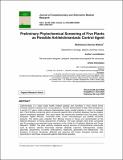| dc.description.abstract | Leishmaniasis is a major public health problem globally and manifests in three clinical forms
including visceral cutaneous and mucocutaneous. Visceral leishmaniasis is fatal if left untreated for
a period of 2 years, while cutaneous leishmaniasis cause crusted papules or ulcers on exposed
skin. Plant families containing active compounds against other protozoan diseases may be suitable
against leishmania parasites. This study report the compounds extracted from five plants (Olea
europaea, Kigelia Africana, Terminalia mollis, Croton macrostachyus and Bridella micrantha
extracts). The plants were collected from Baringo County in Kenya and authenticated at the
National Museums of Kenya (Department of Botany). The plant samples were dried, pulverized
into fine powders and extracted using methanol at the Center for Traditional Medicine and Drugs
Research, KEMRI. The plant extracts contained varying amounts of phytochemical compounds
such as tannins, phenols, flavonoids, steroids, alkaloids, saponins, anthraquinone, cardiac
glycoside, polyphenols, cumarins, anthocyanins, trepenoids, glycosides and triterpenoids. The
presence of tannins, flavanoids, alkaloids and saponins with known biological activities offer
opportunity to test these compounds against leishmania parasites. | en_US |

